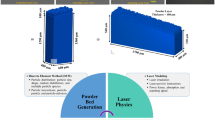Abstract
Automated fiber placement (AFP) process can be used to manufacture laminates by laying up unidirectional slit tapes along a desired path and placing multiple layers on top of each other. Usually, the slit tapes are placed direct onto the tooling to attain the final part geometry. Alternatively, the laminate can be built up on a planar substrate and can be subsequently formed into the final shape. This kind of processing allows manufacturing highly curved parts, which may not be possible with the direct placement. In the present work a forming simulation of thick AFP laminates is developed to predict the tapes’ orientations and delamination as well as transverse tape spread-ups and separations during the forming process. The simulation model is built up through the material characterization experiments. Validation is performed comparing the results of the simulation vs. the experimental forming on two generic geometries. An optical inspection is made on the external layers of the laminates. In a second step, live computer tomography (CT) scans are used to inspect the tapes within an AFP laminate during forming of an L- and a Z-flange. Tapes re-orientation, gaps and tapes widening are observed experimentally and compared to the simulation results. The simulation is capable to predict the tows orientation and provides indicators concerning the tows spread-up and separation.


















Similar content being viewed by others
References
Middendorf P., Metzner C.: Aerospace applications of non-crimp fabric composites. In: Lomov S.V. (ed.) Non-Crimp Fabric Composites - Manufacturing, Properties and Applications, pp. 441–448. Cambridge, Woodhead (2011)
Lukaszewicz D.H., Ward C., Potter K.D.: The engineering aspects of automated prepreg layup: history, present and future. Compos Part B- Eng. 43(3), 997–1009 (2012). doi:10.1016/j.compositesb.2011.12.003
Åström. Manufacturing of polymer composites. London, UK: Chapman & Hall; ISBN: 978–0-7487-7076-2 (1997).
Campbell F.C.: Manufacturing processes for advanced composites. Elsevier Advanced Technology, Oxford ISBN: 9781856174152 (2004)
Lichtinger R., Hörmann P., Stelzl D., et al.: The effects of heat input on adjacent paths during automated fibre placement. Compos Part A-Appl S. 68, 387–397 (2015). doi:10.1016/j.compositesa.2014.10.004
Haanappel SP, Thije RHW ten, Akkerman R. Forming predictions of UD reinforced thermoplastic laminates. ECCM 14, Budapest (2010); http://purl.utwente.nl/publications/74775
Haanappel SP, ten Thije RHW, Sachs U, Rietman B, Akkerman R. Formability analyses of uni-directional and textile reinforced thermoplastics. Compos Part A-Appl S 56: 80–92 (2014). doi/10.1016/j.compositesa.2013.09.009
ten Thije R. Finite element simulations of laminated composites forming processes. Dissertation, Universiteit Twente; ISBN-13: 978–90-365-2546-6 (2007).
Gorczyca J.L., Sherwood J.A., Liu L., Chen J.: Modeling of friction and shear in thermostamping of composites - part I. J. Compos. Mater. 38(21), 1911–1929 (2004). doi:10.1177/0021998304048416
Liu L., Gorczyca J.L., Sherwood J.A.: Modeling of friction and shear in thermostamping of composites - part II. J. Compos. Mater. 38(21), 1931–1947 (2004). doi:10.1177/0021998304048417
Clifford M, Long A, de Luca P. Forming of engineered prepregs and reinforced thermoplastic. In: Proc. 130th Annual Meeting & Exhibition of The Minerals, Metals & Materials Society CTMSJ, New Orleans (2001).
Harrison P., Clifford M.J., Long A.C., Rudd C.D.: A constituent-based predictive approach to modelling the rheologyof viscous textile composites. Compos Part A-Appl S. 35, 915–931 (2004). doi:10.1016/j.compositesa.2004.01.005
Lin H., Wang J., Long A.C., Clifford M.J., Harrison P.: Predictive modelling for optimization of textile composite forming. Compos. Sci. Technol. 67, 3242–3252 (2007). doi:10.1016/j.compscitech.2007.03.040
Badel P., Maire E., Vidal-Sallé E., Boisse P.: Computational determination of the mechanical behavior of textile composite reinforcement. Validation with x-ray tomography. Int J Mater Form. 1(1), 823–826 (2008). doi:10.1007/s12289-008-0262-2
Naouar N., Vidal-Sallé E., Schneider J., Maire E., Boisse P.: Meso-scale FE analyses of textile composite reinforcement deformation based on X-ray computed tomography. Compos. Struct. 116, 165–176 (2014). doi:10.1016/j.compstruct.2014.04.026
Barburski M., Straumit I., Lomov S.V.: Internal structure of the sheared textile composite reinforcement: analysis using X-Ray Tomography". Key Eng. Mater. 651-653, 325–330 (2015). doi:10.4028/www.scientific.net/KEM.651-653.325
PAM-FORM Solver Notes (2009), ESI Group
McGuinness G.B., CM O.B.: Development of rheological models for forming flows and picture-frame shear testing of fabric reinforced thermoplasticsheets. J. Non-Newtonian Fluid Mech. 73, 1–28 (1997)
DIN Bestimmung der Biegesteifigkeit - Verfahren nach Cantilever (53362:2003–10) (2003).
Palfinger W., Thumfart S., Eitzinger C.: Photometric Stereo on Carbon Fiber Surfaces. Steyr-Gleink, Austria (2011)
Schug A.: Validation Method for Evaluating Forming Simulations of Composite Textiles. Diplomarbeit, Technische Universität München (2013)
Hamila N., Boisse P.: Tension locking in finite-element analyses of textile composite reinforcement deformation. Comptes Rendus Mécanique. 341(6), 508–519 (2013). doi:10.1016/j.crme.2013.03.001
Hamila N., Boisse P.: Locking in simulation of composite reinforcement deformations. Analysis and treatment. Compos Part A-Appl S. 39(7), 1167–1176 (2013). doi:10.1016/j.compositesa.2013.06.001
tenThije R., R. A.: Solutions to intra-ply shear locking in finite element analyses of fibre reinforced materials. Compos Part A-Appl S. 53(7), 109–117 (2008). doi:10.1016/j.compositesa.2008.03.014
Yu X., Cartwright B., McGuckin D., Ye L., Mai Y.W.: Intra-ply shear locking in finite element analyses of woven fabric forming processes. Compos Part A-Appl S. 37(5), 790–803 (2006). doi:10.1016/j.compositesa.2005.04.024
Haanappel S., Akkerman R.: Shear characterisation of uni-directional fibre reinforced thermoplastic melts by means of torsion. Compos Part A-Appl S. 56, 8–26 (2014). doi:10.1016/j.compositesa.2013.09.007
Sachs U, Haanappel S, Rietman B, Akkerman R. Friction testing of thermoplastic composites. In: SEICO 11 Paris: SAMPE Europe’s 32nd International Technical Conference and Forum (2011).
Fetfatsidis K., Gamache L., Gorczyca J., Sherwood J.A., Jauffres D., Chen J.: Design of an apparatus for measuring tool/fabric and fabric/fabric friction of woven-fabric composites during the thermostamping process. Int. J. Mater. Form. 6(1), 1–11 (2013). doi:10.1007/s12289-011-1058-3
Margossian A, Ding M, Avila Gray L et al. Flexural Characterisation of Unidirectional Thermoplastic Tapes using a Dynamic Mechanical Analysis system. In: ECCM 16 (2015).
Margossian A., Bel S., Hinterhoelzl R.: Bending characterisation of a molten unidirectional carbon fibre reinforced thermoplastic composite using a dynamic mechanical analysis system. Compos Part A-Appl S. (2015). doi:10.1016/j.compositesa.2015.06.015
Author information
Authors and Affiliations
Corresponding author
Rights and permissions
About this article
Cite this article
Leutz, D., Vermilyea, M., Bel, S. et al. Forming Simulation of Thick AFP Laminates and Comparison with Live CT Imaging. Appl Compos Mater 23, 583–600 (2016). https://doi.org/10.1007/s10443-016-9475-6
Received:
Accepted:
Published:
Issue Date:
DOI: https://doi.org/10.1007/s10443-016-9475-6




